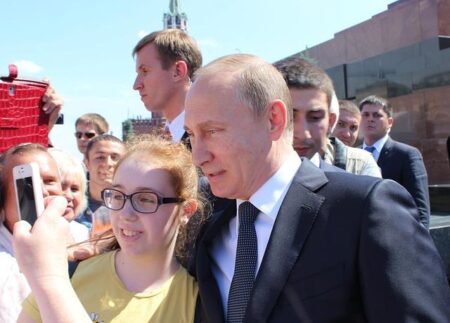In a striking escalation of the ongoing conflict, Ukraine has launched a massive drone attack deep inside Russian territory, exposing vulnerabilities within President Vladimir Putin’s defenses. The unprecedented strike, reported by NBC News, underscores a significant shift in the dynamics of the war, challenging Russia’s perceived strategic superiority and signaling Kyiv’s growing capability to penetrate Russian airspace. As the repercussions of the attack reverberate politically and militarily, analysts weigh its implications for the future trajectory of the conflict.
Ukraine’s Drone Offensive Exposes Critical Weaknesses in Russian Air Defense
In a bold and unprecedented maneuver, Ukrainian forces launched a massive swarm drone attack deep within Russian territory, drastically revealing significant vulnerabilities in Moscow’s air defense network. The operation, involving dozens of small, low-cost drones, slipped past multiple layers of Russian radar and anti-air systems, underscoring the outdated and fragmented nature of their aerial defense strategy. The drones inflicted damage on critical infrastructure, disrupting logistics and communication lines, while exposing gaps in Russia’s capacity to counter low-altitude, high-volume threats effectively.
Experts analyzing the offensive highlighted several key weaknesses identified during the strike, including:
- Limited radar coverage against small and slow-moving targets
- Overreliance on traditional air defense systems unable to handle swarm tactics
- Poor integration between ground-based and aerial interception units
- Delayed response times compromising layered defense mechanisms
| Aspect | Weakness | Impact |
|---|---|---|
| Radar Systems | Poor detection of micro-drones | Increased penetration rate of Ukrainian drones |
| Air Defense Coordination | Fragmented command structure | Slower interception response |
| Counter-Swarm Technology | Insufficient deployment | Reduced area denial capability |
Strategic Implications for Putin as Kremlin Faces Increasing Security Challenges
The recent large-scale drone strike inside Russian territory has dramatically exposed significant vulnerabilities in the Kremlin’s layered security apparatus. As Russia grapples with mounting threats along its borders and now deep within its heartland, Putin’s administration faces an urgent need to reassess its defense priorities. The attack undermines the image of impregnable Russian airspace and signals a potential shift toward asymmetric warfare tactics that could force Moscow into costly overhauls of its air defense systems and intelligence networks.
Key strategic challenges confronting Putin include:
- Erosion of internal security confidence-Raised concerns over the Kremlin’s ability to prevent unexpected incursions.
- Reprioritization of military assets-Increased emphasis on anti-drone technology and electronic warfare.
- Heightened political instability risks-Vulnerabilities may embolden opposition voices and erode public trust.
- Implications for regional power projection-Complications in asserting dominance amidst growing security vulnerabilities.
| Strategic Focus | Potential Kremlin Response | Immediate Impact |
|---|---|---|
| Air Defense Modernization | Deployment of advanced anti-drone radar & missile systems | Short-term disruption, long-term deterrence |
| Information Security | Enhanced cyber and intelligence operations | Improved threat detection |
| Internal Security | Increased surveillance & control measures | Risk of public dissent |
Recommendations for Strengthening Russia’s Counter-Drone Capabilities Amid Escalating Conflict
The recent unprecedented drone incursion has starkly highlighted critical shortcomings in Russia’s current aerial defense systems. To mitigate such vulnerabilities, integrating advanced multi-sensor detection networks that combine radar, electronic warfare, and optical tracking is imperative. This layered approach would enable quicker identification and classification of small, low-flying unmanned aerial vehicles (UAVs) before they penetrate critical infrastructure. Additionally, investing in autonomous interception systems capable of rapid response without human intervention can significantly reduce reaction times and increase the effectiveness of counter-drone operations.
Beyond technological upgrades, fostering inter-agency collaboration and enhancing real-time intelligence sharing will be crucial. The establishment of a centralized command coordinating all counter-drone assets across military, security, and civilian sectors can streamline responses to complex, multi-vector threats. Furthermore, Russia should prioritize the development of tailored drone jamming technologies that disrupt hostile UAV communication links without interfering with friendly forces. Below is a simplified overview of strategic measures recommended:
| Focus Area | Key Initiative | Expected Outcome |
|---|---|---|
| Detection | Multi-sensor fusion networks | Enhanced early warning |
| Interception | Autonomous defense drones | Faster threat neutralization |
| Coordination | Integrated command centers | Unified response efforts |
| Electronic Warfare | Targeted drone jamming | Disruption of hostile UAVs |
In Conclusion
As Ukraine continues to demonstrate its growing capability to strike deep within Russian territory, the recent drone attack underscores a significant challenge to Kremlin security and exposes vulnerabilities in Putin’s defenses. This development not only signals a shift in the tactical dynamics of the conflict but also raises critical questions about Russia’s preparedness in the face of evolving Ukrainian strategies. As the situation unfolds, the international community watches closely, recognizing that the resilience and adaptability of both sides will shape the future trajectory of this enduring conflict.




